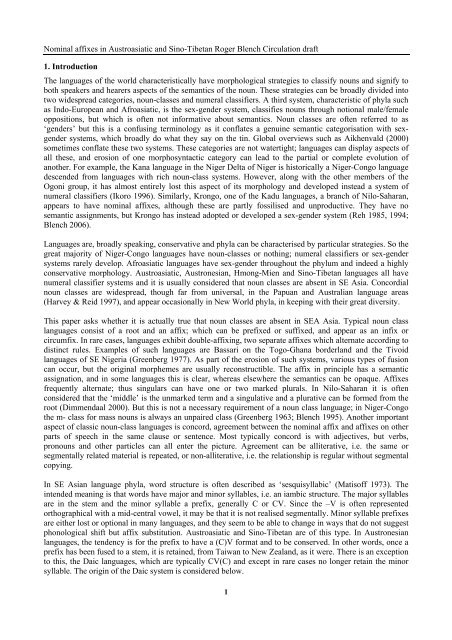The origins of nominal affixes in Austroasiatic and ... - Roger Blench
The origins of nominal affixes in Austroasiatic and ... - Roger Blench
The origins of nominal affixes in Austroasiatic and ... - Roger Blench
Create successful ePaper yourself
Turn your PDF publications into a flip-book with our unique Google optimized e-Paper software.
Nom<strong>in</strong>al <strong>affixes</strong> <strong>in</strong> <strong>Austroasiatic</strong> <strong>and</strong> S<strong>in</strong>o-Tibetan <strong>Roger</strong> <strong>Blench</strong> Circulation draft<br />
1. Introduction<br />
<strong>The</strong> languages <strong>of</strong> the world characteristically have morphological strategies to classify nouns <strong>and</strong> signify to<br />
both speakers <strong>and</strong> hearers aspects <strong>of</strong> the semantics <strong>of</strong> the noun. <strong>The</strong>se strategies can be broadly divided <strong>in</strong>to<br />
two widespread categories, noun-classes <strong>and</strong> numeral classifiers. A third system, characteristic <strong>of</strong> phyla such<br />
as Indo-European <strong>and</strong> Afroasiatic, is the sex-gender system, classifies nouns through notional male/female<br />
oppositions, but which is <strong>of</strong>ten not <strong>in</strong>formative about semantics. Noun classes are <strong>of</strong>ten referred to as<br />
‘genders’ but this is a confus<strong>in</strong>g term<strong>in</strong>ology as it conflates a genu<strong>in</strong>e semantic categorisation with sexgender<br />
systems, which broadly do what they say on the t<strong>in</strong>. Global overviews such as Aikhenvald (2000)<br />
sometimes conflate these two systems. <strong>The</strong>se categories are not watertight; languages can display aspects <strong>of</strong><br />
all these, <strong>and</strong> erosion <strong>of</strong> one morphosyntactic category can lead to the partial or complete evolution <strong>of</strong><br />
another. For example, the Kana language <strong>in</strong> the Niger Delta <strong>of</strong> Niger is historically a Niger-Congo language<br />
descended from languages with rich noun-class systems. However, along with the other members <strong>of</strong> the<br />
Ogoni group, it has almost entirely lost this aspect <strong>of</strong> its morphology <strong>and</strong> developed <strong>in</strong>stead a system <strong>of</strong><br />
numeral classifiers (Ikoro 1996). Similarly, Krongo, one <strong>of</strong> the Kadu languages, a branch <strong>of</strong> Nilo-Saharan,<br />
appears to have <strong>nom<strong>in</strong>al</strong> <strong>affixes</strong>, although these are partly fossilised <strong>and</strong> unproductive. <strong>The</strong>y have no<br />
semantic assignments, but Krongo has <strong>in</strong>stead adopted or developed a sex-gender system (Reh 1985, 1994;<br />
<strong>Blench</strong> 2006).<br />
Languages are, broadly speak<strong>in</strong>g, conservative <strong>and</strong> phyla can be characterised by particular strategies. So the<br />
great majority <strong>of</strong> Niger-Congo languages have noun-classes or noth<strong>in</strong>g; numeral classifiers or sex-gender<br />
systems rarely develop. Afroasiatic languages have sex-gender throughout the phylum <strong>and</strong> <strong>in</strong>deed a highly<br />
conservative morphology. <strong>Austroasiatic</strong>, Austronesian, Hmong-Mien <strong>and</strong> S<strong>in</strong>o-Tibetan languages all have<br />
numeral classifier systems <strong>and</strong> it is usually considered that noun classes are absent <strong>in</strong> SE Asia. Concordial<br />
noun classes are widespread, though far from universal, <strong>in</strong> the Papuan <strong>and</strong> Australian language areas<br />
(Harvey & Reid 1997), <strong>and</strong> appear occasionally <strong>in</strong> New World phyla, <strong>in</strong> keep<strong>in</strong>g with their great diversity.<br />
This paper asks whether it is actually true that noun classes are absent <strong>in</strong> SEA Asia. Typical noun class<br />
languages consist <strong>of</strong> a root <strong>and</strong> an affix; which can be prefixed or suffixed, <strong>and</strong> appear as an <strong>in</strong>fix or<br />
circumfix. In rare cases, languages exhibit double-affix<strong>in</strong>g, two separate <strong>affixes</strong> which alternate accord<strong>in</strong>g to<br />
dist<strong>in</strong>ct rules. Examples <strong>of</strong> such languages are Bassari on the Togo-Ghana borderl<strong>and</strong> <strong>and</strong> the Tivoid<br />
languages <strong>of</strong> SE Nigeria (Greenberg 1977). As part <strong>of</strong> the erosion <strong>of</strong> such systems, various types <strong>of</strong> fusion<br />
can occur, but the orig<strong>in</strong>al morphemes are usually reconstructible. <strong>The</strong> affix <strong>in</strong> pr<strong>in</strong>ciple has a semantic<br />
assignation, <strong>and</strong> <strong>in</strong> some languages this is clear, whereas elsewhere the semantics can be opaque. Affixes<br />
frequently alternate; thus s<strong>in</strong>gulars can have one or two marked plurals. In Nilo-Saharan it is <strong>of</strong>ten<br />
considered that the ‘middle’ is the unmarked term <strong>and</strong> a s<strong>in</strong>gulative <strong>and</strong> a plurative can be formed from the<br />
root (Dimmendaal 2000). But this is not a necessary requirement <strong>of</strong> a noun class language; <strong>in</strong> Niger-Congo<br />
the m- class for mass nouns is always an unpaired class (Greenberg 1963; <strong>Blench</strong> 1995). Another important<br />
aspect <strong>of</strong> classic noun-class languages is concord, agreement between the <strong>nom<strong>in</strong>al</strong> affix <strong>and</strong> <strong>affixes</strong> on other<br />
parts <strong>of</strong> speech <strong>in</strong> the same clause or sentence. Most typically concord is with adjectives, but verbs,<br />
pronouns <strong>and</strong> other particles can all enter the picture. Agreement can be alliterative, i.e. the same or<br />
segmentally related material is repeated, or non-alliterative, i.e. the relationship is regular without segmental<br />
copy<strong>in</strong>g.<br />
In SE Asian language phyla, word structure is <strong>of</strong>ten described as ‘sesquisyllabic’ (Matis<strong>of</strong>f 1973). <strong>The</strong><br />
<strong>in</strong>tended mean<strong>in</strong>g is that words have major <strong>and</strong> m<strong>in</strong>or syllables, i.e. an iambic structure. <strong>The</strong> major syllables<br />
are <strong>in</strong> the stem <strong>and</strong> the m<strong>in</strong>or syllable a prefix, generally C or CV. S<strong>in</strong>ce the –V is <strong>of</strong>ten represented<br />
orthographical with a mid-central vowel, it may be that it is not realised segmentally. M<strong>in</strong>or syllable prefixes<br />
are either lost or optional <strong>in</strong> many languages, <strong>and</strong> they seem to be able to change <strong>in</strong> ways that do not suggest<br />
phonological shift but affix substitution. <strong>Austroasiatic</strong> <strong>and</strong> S<strong>in</strong>o-Tibetan are <strong>of</strong> this type. In Austronesian<br />
languages, the tendency is for the prefix to have a (C)V format <strong>and</strong> to be conserved. In other words, once a<br />
prefix has been fused to a stem, it is reta<strong>in</strong>ed, from Taiwan to New Zeal<strong>and</strong>, as it were. <strong>The</strong>re is an exception<br />
to this, the Daic languages, which are typically CV(C) <strong>and</strong> except <strong>in</strong> rare cases no longer reta<strong>in</strong> the m<strong>in</strong>or<br />
syllable. <strong>The</strong> orig<strong>in</strong> <strong>of</strong> the Daic system is considered below.<br />
1
















